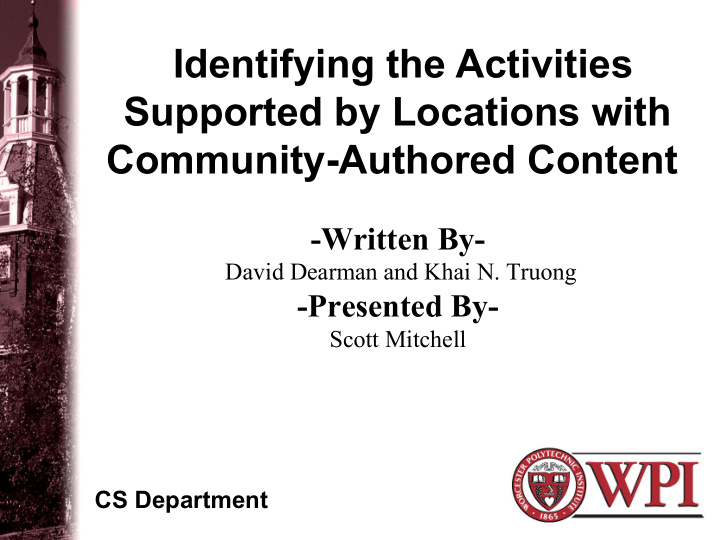



Identifying the Activities Supported by Locations with Community-Authored Content -Written By- David Dearman and Khai N. Truong -Presented By- Scott Mitchell CS Department
Problem Domain • Determine types of activities which are possible at a given location – The set of activities is dynamic 2 Worcester Polytechnic Institute
“Traditional” Context Aware • Low cost, integrated into environment – RFID, infra-red, accelerometer • Designed to correlate specific sequence of actions to a specific event – Scalability – Recognition of dynamic nature tasks 3 Worcester Polytechnic Institute
Alternative Context Aware • Traditional methods do not apply well when activities are “intertwined” • Location activities can not be determined a priori • Use content provided by the community – Scalability – Dynamic in nature – Determine potential user activities 4 Worcester Polytechnic Institute
Natural Language Processing • From: Yelp – popular community driven location review site • How: Verb-Noun Pairs – Check zoo – Play chess 5 Worcester Polytechnic Institute
Architecture • Harvest – Name, URL, latitude, longitude, number of reviews • Parse – Stanford Part-Of-Speech Tagger (English maximum entropy sentence tokenizer) • Tag and Extract – Activity finder pairs verbs with nouns if < 5 words away – Perspective (1 st I, we, 2 nd you, 3 rd he, she) – Original and base words retained • Populate and Update 6 – Quick access of word-pairs Worcester Polytechnic Institute
Experimental Approach • 14 diverse locations • Participants – provide activities performed/experienced at locations – validate 40 most common verb-noun pairs – True Positive – participant validated – False Positive – participant rejected 7 – False Negative – not in most common Worcester Polytechnic Institute
Questions / Comments • More details coming up...wake up 8 Worcester Polytechnic Institute
Measurement Tools • Precision = False Positive / True Positive • Recall = True Positive / False Negative • Filter applied to noun-verb pairs to reduce number of false positives – None, 1 st Person, Frequency > 1 • Known activity to identified verb-noun pairs – Exact Terms – Similar Terms – statistically similar permutations of base words – Synonyms 9 Worcester Polytechnic Institute
Results • Precision – Averaged across 14 locations • Average Precision – Considers ranked order of noun-verb relevance • 57 average known activities per location (participant provided + participant validated) – Limits recall to a max of 70.2%. – Observed 55.5% recall rate. 10 Worcester Polytechnic Institute
Results Continued • Participant verb- noun pair recognition relatively low – 16.4% using synonymous terms – 83.6% false negatives • Number of reviews considered influences recognition 11 Worcester Polytechnic Institute
Clustering • Grounded Theory Affinity Clustering – Abstract activities into very high level • Physical (buy a book) • Cognativie(enjoy art...) • Perceptual (watch people...) 12 Worcester Polytechnic Institute
Real Life Applications 13 Worcester Polytechnic Institute
Questions / Comments • Natural Language Limitations? – Single sentence analysis • Simplistic Frequency Analysis? – 40 most common verb-noun pairs 14 Worcester Polytechnic Institute
Recommend
More recommend